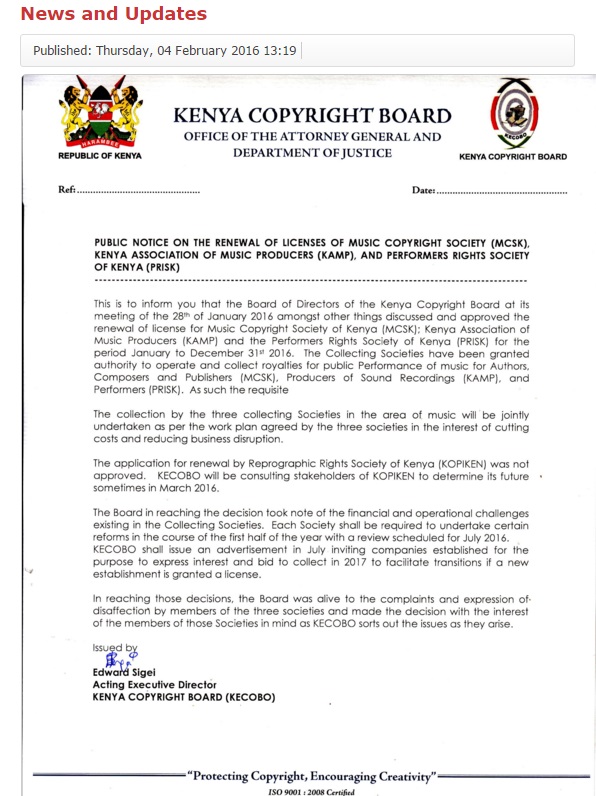
Last week, the ever-busy Kenya Copyright Board (KECOBO) published a public notice stating that it had approved the renewals of registration as collecting societies for Music Copyright Society of Kenya (MCSK), Kenya Association of Music Producers (KAMP) and Performers Rights Society of Kenya (PRiSK) for the period January 1st to December 31st 2016. According to KECOBO, the collection by the three collecting societies in the area of music will be “jointly undertaken as per the work plan agreed by the three societies in the interest of cutting costs and reducing business disruption.”
Further, KECOBO explains that: “Each [collecting] society shall be required to undertake certain reforms in the course of the first half of the year with a review scheduled for July 2016. KECOBO shall issue an advertisement in July [2016] inviting companies established for the purpose to express interest and bid to collect in 2017 to facilitate transitions if a new establishment is granted a license.”
For KECOBO and the collecting societies this is no mean feat given the long journey thus far towards a single license regime for users of musical works and sound recordings in Kenya. However, KECOBO’s notice leaves out some crucial details which will ultimately determine whether this latest attempt at joint collection will succeed or fail.
Presumably, in this “workplan” mentioned by KECOBO, there is a requirement that all three collective management organisations (CMOs) will open a joint bank account and new joint mobile money payment accounts. It is clear that each CMO will be collecting on its behalf and that of the other CMOs at least until July 2016. This part should be straightforward for users since there is already a joint tariff awaiting approval and gazettement. One hopes that all three CMOs have identical license periods for users which coincide with the January to December calendar year. In this connection, one presumes that the 3 CMOs have already agreed on the percentage split of the total collections from licenses issued for the period of the “workplan”. The most likely MCSK-KAMP-PRISK percentage split would be 60-20-20 but it may be as low as 50-25-25 since anything lower would be inconceivable. The split could also vary across license categories such as communication to the public, broadcasting, digital platforms etc.
Things will get interesting in July 2016. One wonders whether any of the existing CMOs will be permitted to bid for joint collection license in 2017. If no, it will be interesting to know whether KECOBO will restrict the invitation for bids only to entities registered as companies limited by guarantee. The selection criteria and the role of the existing CMOs in the bid review process would be important to know. Once the bid winner is selected, what will be the relationship between this entity and the existing CMOs? Will it be a shareholding relationship? A contractual relationship? In short, members of the three CMOs must be told in clear terms how much this new arrangement would cost them and how much they stand to gain, if applicable, from this new joint collection arrangement.
This blogger will be monitoring the developments on this matter very closely.
It would be interesting to see how musicians whom now produce their own musical works can be assimilated between all the three CMO fielding. Personally as Melodica Music Stores I have always stood for the rights of musicians and artists above. As a producer I am all for the equal and rightful distribution of revenue to all the parties within the three. It is a good time in the music industry if only the correct structure and it’s implementation will be observed by all parties.